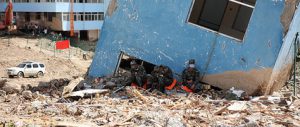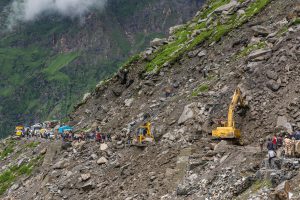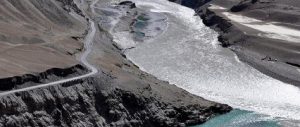As we saw in part one, thanks to human adaptability, landslides not only bring “perils” but also create landscapes with long-term benefits for human settlement. Now I will tell the story of some of these communities living in the Upper Indus Valley.
Ghoro Cho (“heap of great stones”) comprises a series of boulder-covered ridges across the floor of Shigar Valley, northern Pakistan. Early in my investigations, I stayed there in the shepherds’ hut at Kor-Kor-Tsok-Boo. One evening, having heard of my interest, my host, Haji Ali elected to tell me the “real” story of the great stones. It was after supper and we sat around the open fire, the animals milked and settling down in the corrals, Haji Ali’s face alternately lit by the flames or obscured by the smoke.
Long ago, he said, where Ghoro Cho now lies, there was a great and prosperous city. A travelling holy man came there and asked the ruler, the Rajah, for food and shelter. He was turned away, and by other wealthy folk. At last a poor woman gave him shelter and shared her food. Next morning he told her to climb to some springs high above the valley floor. He went to the opposite side and smote the rock with his staff. A great part of the mountain came down, burying the city, its wealth and pride.
Haji Ali’s story resembles morality tales about disasters in many places, including other Karakoram landslides. It may seem more myth than fact. Yet the details are singular, and whoever crafted the story was a fair geologist or landscape detective. Next morning the storyteller walked with me, pointing out the huge scar on the mountain side struck by the holy man. Opposite, he identified Mango village and its springs where the old woman remained safe above the cataclysm. He showed me many features among the boulders of Ghoro Cho that proved valuable in reconstructing its geological as well as human story. Visiting the scar on the mountain side, I found green crystalline bedrock identical to Ghoro Cho boulders. Just 100 metres below Mango village, I found the outermost boulders and tell-tale greenish deposits marking the landslide rim.
However, this is also important in relation to another story – one from modern geoscience. For over a century, Ghoro Cho was interpreted by earth scientists as moraine: debris dumped by glaciers during the Ice Age. I had passed it many times assuming the ridges were moraines, an easy mistake to make. But Haji Ali had the answer to definitively separate landslides from moraines – through rock type.
The boulders and other visible fragments of Ghoro Cho consist entirely of that green crystalline rock of the source slope, whereas glaciers carry quite different rock types, and of great variety – much as the rivers do today. Meanwhile, rock avalanche particles, have the tell-tale angular character of fractured and crushed material. Moraines of large glaciers have diverse particle shapes including stones rounded in melt-water streams.
Of course, rock type analysis is bread-and-butter for any trained geoscientist, but in this case no one thought it necessary to check out the particle shapes. The most influential studies from the 1850s to the 1980s offered compelling interpretations of Ghoro Cho as glacial. The author of Haji Ali’s story knew better, but the moraine hypothesis prevailed until the 1990s.
Ghoro Cho can be a formidable place, dark and forbidding from a distance, mostly barren and swept daily by dust storms. Yet, every square inch is known to local people. Too far from water for cultivation, the area serves mainly as grazing land. Cave homes for shepherd families and their animals lie under the largest boulders, and the residents have names for every feature. Many other stories are told, recalling the wolves, bears and Siberian tigers that once sought refuge among the boulders; dangerous djinns or “fairies”; and heroes from the Kesar Saga, the great oral epic of Shigar valley. Among these narratives are solid grains of empirical and practical truth, useful as environmental knowledge or contributing to a sense of place, history and calamity.
The village of Gol on the Indus is a typical oasis of human-made greenery amid bare rock walls, closely adapted to features developed after a landslide descended from nearby mountain walls. In fact, debris from two megaslides blocks the Indus here for 11 kilometres. Gol itself was once the site of a rock-slide entrapped lake 500 metres deep and at least 90 kilometres long. Boulder-covered mounds support homes and schools, the mosque and dispensary. Residents grow hardy crops on a small area of arable ground left by the landside lake and graze animals over the mounds of landslide debris. Farms and fields are also scattered over river terraces recording the sequence of incision by the river.
Of course, the hands of local farmers and their wives have made the terraced fields, fertile soil and channels to carry irrigation water. Stone from the landslide is used for terracing and other construction, broken from boulders left conveniently on the valley floor. The villagers at Gol have their stories too, telling of a former lake and boats tied up at places far above today’s river; of the cataclysm that created the lake; and of a flood from up-valley that destroyed it. I suspect this also reflects an eye for landscape more than remembered history. At least, our age determinations put the landslide at 4,300 years ago (plus or minus 170 years) – long before permanent settlement.
Many villages like Gol occupy landforms developed through landslide interruptions. Skardu and Khapalu, the main towns of Baltistan, are spread over rock avalanche areas. At Skardu and Gilgit the airports lie on terrace levels related to former landslide dams. Taxiing from the runway at Skardu, you pass bluffs in fine-grained yellow sediments laid down in a vast lake dammed by the landslide at Katzarah. One can only marvel at the extraordinary range of resources and uses people have found for the landslides.
Although the region is nearly as difficult to cross as it is to inhabit, it has been the route for Buddhist pilgrims moving between the subcontinent, China and Tibet for at least 2,000 years. These travellers followed the Karakoram Indus valleys, and marked the way with images of the Buddha, stupas, hand prints and inscriptions.
Some of the earliest records of human presence, rock carvings and inscriptions, are found on rock avalanche boulders or rocks polished by the rivers cutting through them. This includes Ghoro Cho and Gol. It seems that indigenous peoples and ancient travellers identified these as special localities, often as sacred places. The greatest concentration of petroglyphs, possibly up to 5,000 years old, lies between Rakhiot Bridge and Shatial along the Indus River. Perhaps there are exceptional numbers of suitable sites, or the landscape inspired a special awe in early residents and travellers.
Either way, every part of the Indus valley here is shaped by large landslides and their interruption cycles. Thanks to them, land suitable for cultivation supports quite heavy settlement today, although plans for a major hydroelectric dam would drown much of it and the petroglyphs. Proponents evidently are unconcerned by the danger of great landslides.
Another famous site, the Sacred Rock of Hunza, is covered in pre- and post-Buddhist petroglyphs spanning thousands of years. It is located where a 1.5 cubic kilometre rock avalanche descended from precipitous mountain walls some 2,000 metres above. The rock avalanche now provides the foundations of Baltit palace, thought to be over 700 years old and recently restored as a World Heritage Site. In general, the classic landscapes of Hunza are adapted to features controlled by this and other landslides – the countless terraces, the fruit tree blossoms of spring, bright green crops in summer and orange expanses of apricots in Fall.
Kenneth Hewitt is professor emeritus in geography and environmental studies and research associate at the Cold Regions Research Centre at Wilfrid Laurier University in Ontario, Canada. This is an updated version of an earlier article, published in the American Scientist in 2010.
Homepage image from alles-schlumpf



